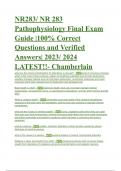NR283/ NR 283
Pathophysiology Final Exam
Guide |100% Correct
Questions and Verified
Answers| 2023/ 2024
LATEST!!- Chamberlain
✅✅
what are the clinical manifestation for alterations in arousal? - -level of conscious changes
which is the most critical evidence, pattern of breathing evaluates level of brain dysfunction,
pupillary changes indicate level of brain stem dysfunction, oculomotor responses and motor
response which help evaluate level of dysfunction and damaged side
Brain Death is what? - ✅✅ -total brain death, body can no longer maintain internal
homeostasis, unresponsive coma, no spontaneous respirations, no brain stem function and flat
EEG
What is cerebral death? - ✅✅ -irreversible coma and death of the cerebral hemispheres
exclusive of the brain stem and cerebellum, and the bran can continue to maintain internal
homeostasis.
what are the 4 types of cerebral death? -✅✅ -coma, vegetative state which they can open
their eyes and have normal sleep, minimal conscious state which they have small movements
and follow commands and locked-in syndrome which the brain is conscious and body is
paralyzed.
what is a seizure -✅✅ -sudden, transient, alteration of brain function caused by abrupt
discharge of cerebral neurons
what is the cause of a seizure - ✅✅-cerebral lesions or trauma, biochemical disorders
Epilepsy is what, and results from what? - ✅✅-continuous seizure with no known trigger,
results from interaction of mutations and environmental factors and epileptic neurons.
, What are the phases of seizures? - ✅✅ -tonic phase which is contraction, clonic phase which
is relaxation and postictal phase which is sleepiness or tired.
what are the CM of seizures? - ✅✅
-aura which is a warning sign, prodroma which are physical
symptoms, fatigue, N and headache, increase in oxygen consumption, prolonged seizure can
cause damage
what are the 3 types of dysphasia? - ✅✅ -expressive which is Broca and deficit of expression,
receptive which is wernicke and deficit of comprehension, and transcortical which is echolalia.
what is acute confusional state or ACS - ✅✅-transient disorder of awareness that result from
cerebral dysfunction.
ACS is caused by - ✅✅-secondary to drug intoxication, metabolic disorder, nervous system
disease
ACS cm - ✅✅ -impaired or lost detection, inability to concentrate, restless, irritable, and
compulsive behavior
✅✅-more severe type of ACS, with worsening symptoms.
what is delirium -
what is dementia - ✅✅-group of symptoms that cause progressive failure of cerebral functions
of orientation, memory, language, behavior and judgement and decision making
dementia CM and causes - ✅✅-infection, atherosclerosis, trauma, and genetics
alzheimer disease or AD is caused by - ✅✅-deficiencies of neurochemical factors, trauma and
genetic mutations
AD pathologic features are - ✅✅-neuron tangles, plaques and degeneration
AD CM IS WHAT - ✅✅-forgetfulness, emotional upset, memory loss, confusion, mood
changes, problem solving and judgement difficulty
✅✅
increased intracranial pressure or IICP is caused by and what are the 4 stages -
-increased in intracranial content, stage 1 there is no change in ICP, stage 2 there is slight
ICP change with expansion, stage 2 there is hypoxic tissue and deterioration, stage 4 there is
herniation of brain tissue
what is a cerebral edema, where does it occur and cause - ✅✅ -increase in fluid in the brain,
which occurs after brain injury and will cause harmful effects by distorting and displacing tissue




